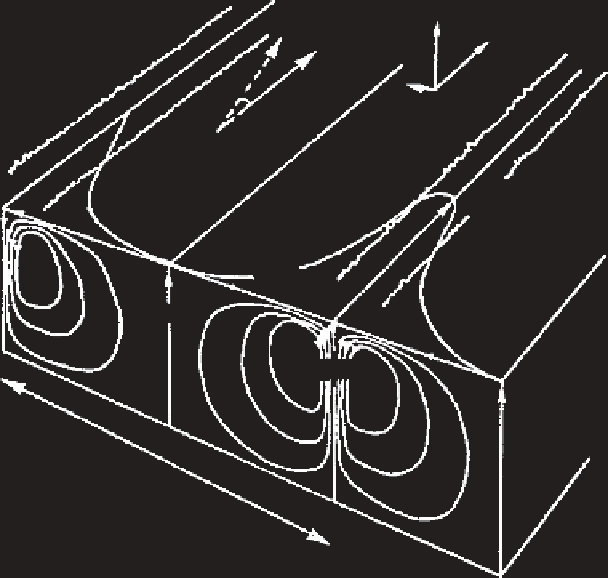Environmental Engineering Reference
In-Depth Information
z
x
Wind
α
<
15°
y
u
-10 cm s
-1
relative to
divergence zone
v
w
1-2 cm s
-1
w
2-6 cm s
-1
FIGURE 13.6
Langmuir circulation cell. (From Ford, D.E. and Johnson, L.S., An assessment of reservoir
mixing processes, U.S. Army Engineers Waterways Experiment Station, Vicksburg, MS, 1986; After Pollard,
R.T., Rhines, P.B., and Thompson, R.O.R.Y.,
Geophysical Fluid Dynamics
3, 381-404, 1973.)
Once hydropower withdrawals cease, momentum will cause the water to pile up at the dam and to
ultimately form a seiche (Martin and McCutcheon 1999).
For example, wind blowing across a lake for a sustained period will result in water piling
up on the far shore, such as a storm surge. The increase in the water-surface elevation at the
downwind lake boundary is wind set-up, while on the opposite side the water-surface elevation
is depressed (wind set-down). Figure 13.7 illustrates a 7-ft. seiche on Lake Erie, observed during
2003, with the wind set-up on the eastern shore and the wind set-down on the western shore. After
the wind subsides, the water-surface tilt or displacement results in a sloshing motion, or a seiche
of the lake surface. As the rocking or sloshing motion takes place, potential energy is converted
to kinetic energy and dissipated (Figure 13.8). Over time, the wave magnitude or the wave height
decreases or decays as bottom friction causes potential energy to be converted into kinetic energy
and dissipated.
The seiche can oscillate around a single point, called a uninodal seiche. Where pressure is exerted
on the center of the lake and then released, a bimodal seiche is generated (Figure 13.8). Multimodal
seiches have also been observed with up to 17 nodes (Wetzel 2001).
Surface seiches are often relatively small in magnitude. However, for lakes with large fetch,
seiches can be quite large. For example, Lake Erie is relatively long (maximum of 210 mi.) and
narrow (57 mi.), so that wind blowing along the length of the lake can result in large variations in
water-surface elevations and large seiches. Martin and McCutcheon (1999) demonstrated that a
set-up of 3 ft. for Lake Erie requires a wind speed of about 30 mph. A 7-ft. seiche is illustrated in
Figure 13.7, but surface seiches of up to 16 ft. have been observed. These elevation changes, associ-
ated with storm surges, are in addition to surface waves, which can add an additional 10 ft. or more
to the total elevation change.

Search WWH ::

Custom Search